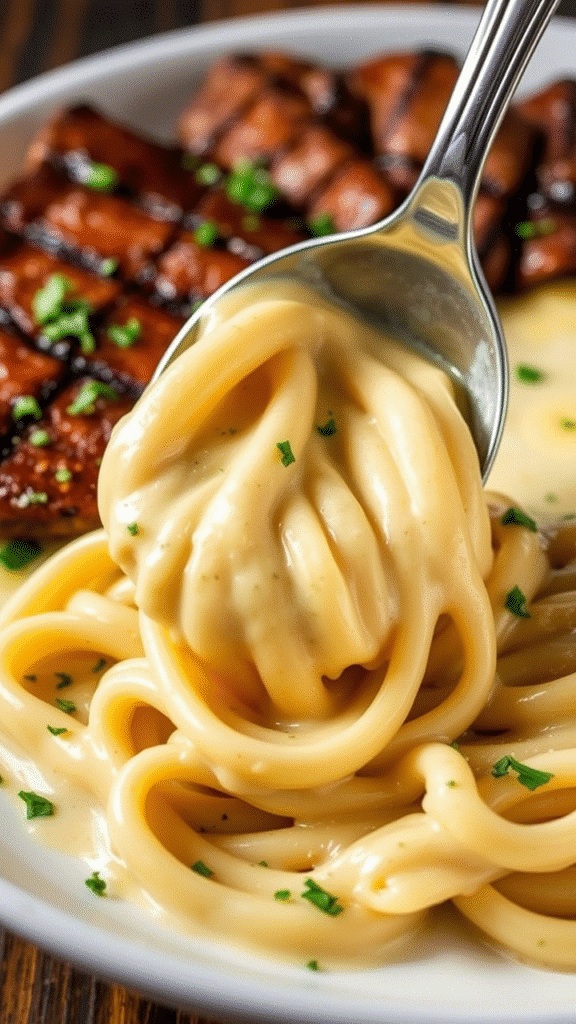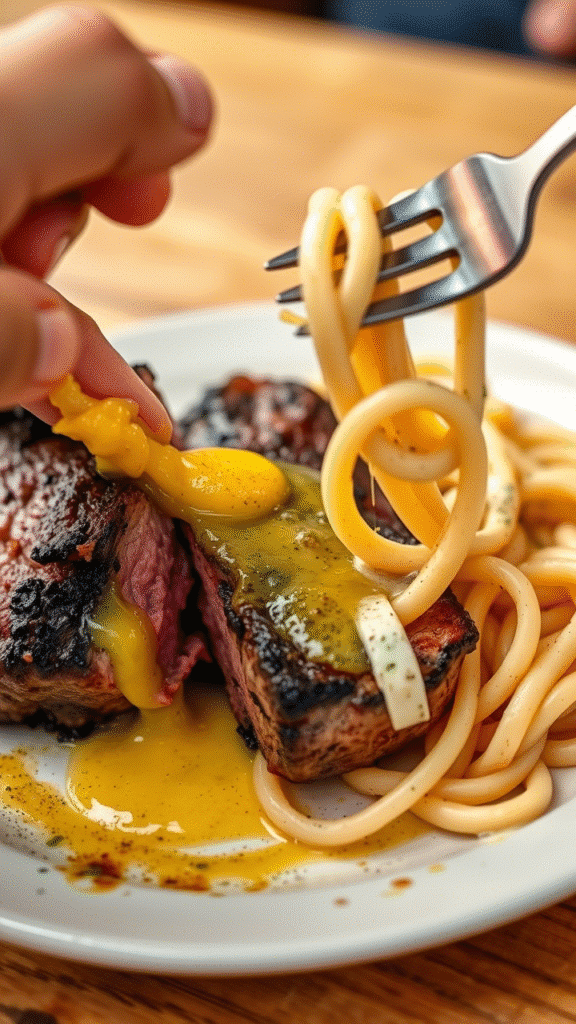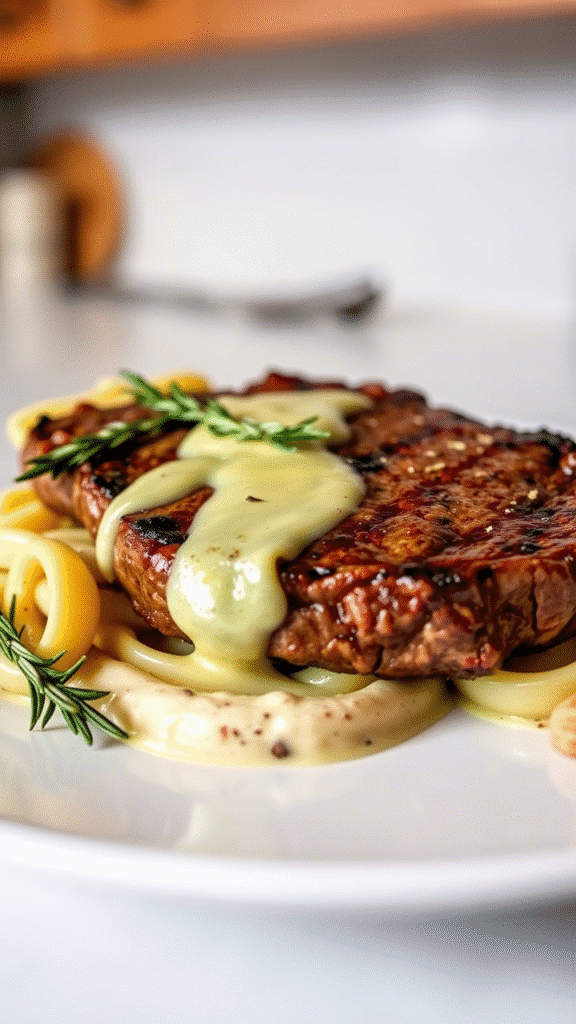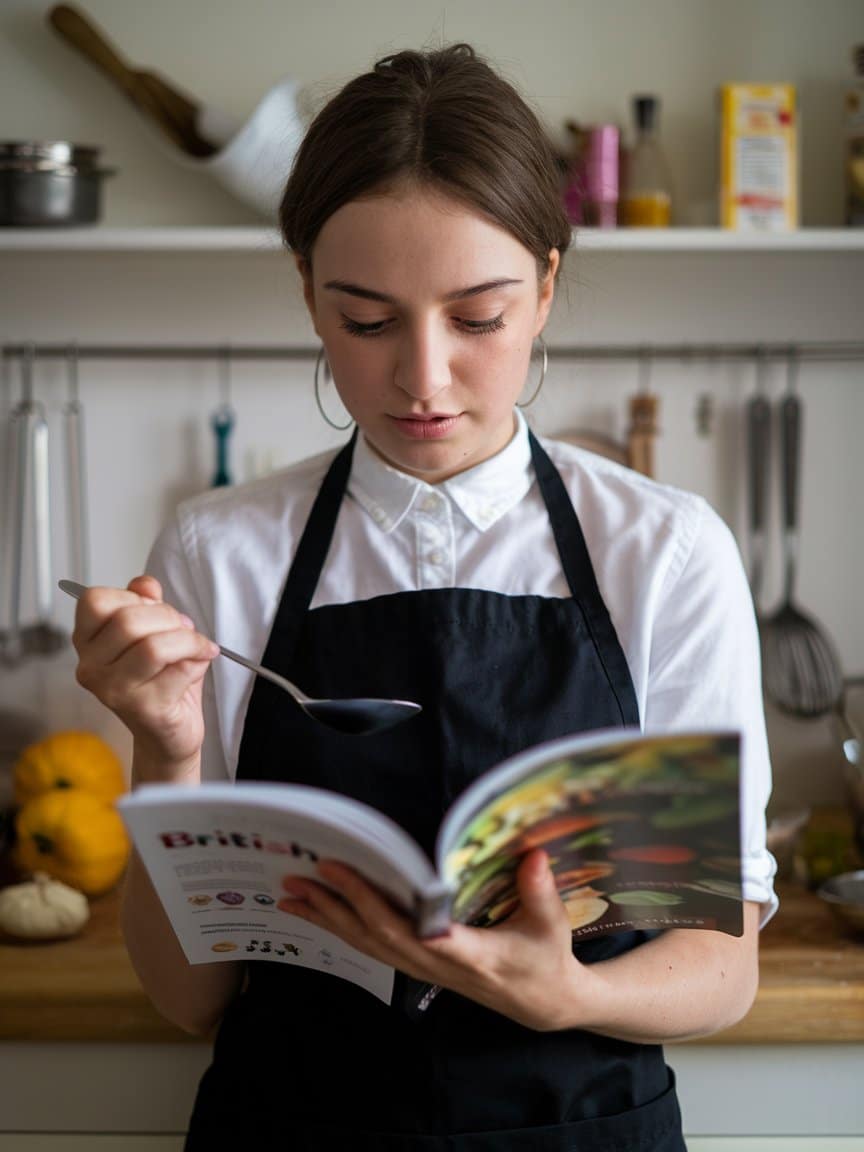Last summer, while working the line at a bustling steakhouse in Chicago, I watched a young cook struggle with what should have been a simple dish steak and pasta. His steak was grey throughout, the pasta swimming in a broken cream sauce that looked more like cottage cheese than silk. That moment reminded me why this seemingly straightforward combination requires genuine technique and understanding of how proteins, starches, and fats interact on the plate.
Garlic butter steak with creamy Parmesan rigatoni represents the perfect marriage of American steakhouse tradition and Italian pasta mastery. This dish isn’t just about throwing beef and noodles together it’s about creating two components that enhance each other while maintaining their individual identities. The key lies in timing, temperature control, and understanding how umami compounds from aged cheese and caramelized meat create layers of flavor that keep diners coming back.
What makes this particular pairing special is the textural contrast between the firm, caramelized exterior of perfectly seared steak and the al dente bite of rigatoni tubes that capture every drop of that silky Parmesan cream. It’s comfort food elevated to restaurant quality.
Understanding Your Proteins and Starches
Steak Selection and Preparation
The foundation of this dish starts with choosing the right cut. Ribeye, New York strip, or filet mignon all work beautifully, but each brings different characteristics to the plate. Ribeye offers the most marbling, which translates to flavor and forgiveness during cooking. Strip steaks provide a firmer texture with good beef flavor, while filet mignon delivers tenderness but requires more careful seasoning since it’s naturally mild.
Your steak should be at least 1-inch thick anything thinner makes achieving that perfect medium-rare nearly impossible without overcooking the exterior. Remove it from refrigeration 30-45 minutes before cooking. This isn’t just chef pretentiousness; cold meat hitting hot oil creates uneven cooking and that dreaded grey band beneath the crust.
Pat the surface completely dry with paper towels. Moisture is the enemy of browning, and browning is where flavor lives. Season generously with kosher salt and freshly cracked black pepper at least 20 minutes before cooking, allowing the salt to penetrate and begin breaking down muscle fibers.
Rigatoni: The Perfect Pasta Choice
Rigatoni’s tubular shape and ridged exterior make it ideal for capturing cream sauce. Those ridges aren’t just decorative they create surface area that helps sauce cling to each piece. The hollow center traps pockets of creamy goodness, ensuring every bite delivers flavor.
Cook your rigatoni 2 minutes shy of the package directions. It will finish cooking in the cream sauce, absorbing flavor while maintaining that crucial al dente texture. Reserve at least 2 cups of pasta cooking water before draining that starchy, salty liquid is liquid gold for adjusting sauce consistency.
Essential Ingredients and Smart Substitutions

For the Steak
- 2 ribeye steaks, 1-1.5 inches thick (8-10 oz each)
- 4 tablespoons unsalted butter
- 6 garlic cloves, smashed and peeled
- 2 sprigs fresh thyme
- 2 sprigs fresh rosemary
- Kosher salt and freshly ground black pepper
- 2 tablespoons neutral oil with high smoke point (avocado or grapeseed)
Substitutions: If ribeye isn’t available, NY strip works excellently. For a leaner option, tenderloin medallions cook faster but need more attention. Compound butter made with herbs and garlic can replace plain butter if you’re short on time.
For the Rigatoni
- 1 pound rigatoni pasta
- 2 cups heavy cream (36% fat minimum)
- 1½ cups freshly grated Parmigiano-Reggiano
- ½ cup freshly grated Pecorino Romano
- 4 tablespoons unsalted butter
- 3 garlic cloves, minced fine
- ¼ cup dry white wine (optional but recommended)
- Fresh parsley, chopped fine
- Black pepper and salt to taste
Substitutions: Half-and-half can replace heavy cream, though you’ll need to add a tablespoon of flour whisked in cold to prevent breaking. Pre-grated cheese works in a pinch, but freshly grated melts more smoothly and tastes significantly better. Good Pecorino Romano adds sharpness that balances the cream’s richness don’t skip it.
Step-by-Step Professional Technique
Preparing the Steak
Heat a cast-iron or heavy-bottomed stainless steel pan over medium-high heat until it’s smoking hot. Add your neutral oil and swirl to coat. The oil should shimmer and move like water this indicates proper temperature.
Gently lay the steak away from you to avoid splatter. Don’t move it, don’t press it, don’t even look at it funny for 3-4 minutes. You’ll hear aggressive sizzling initially, which will calm down as moisture evaporates and browning begins. The steak will release naturally when properly seared.
Flip once when a golden-brown crust has formed. Add butter, smashed garlic, and herbs to the pan. Tilt the pan and baste continuously with the foaming butter, using a spoon to shower the steak’s surface. This technique, called arroser in French kitchens, ensures even cooking and adds incredible flavor depth.
For medium-rare, the internal temperature should reach 125-130°F. Remove from heat and let rest on a cutting board for 5-8 minutes. This resting period allows juices to redistribute throughout the meat skip it and you’ll have a puddle of juices on your cutting board instead of in your steak.
Building the Cream Sauce
While your steak rests, start the rigatoni in heavily salted boiling water. The water should taste like seawater this is your only chance to season the pasta itself.
In a large sauté pan, melt butter over medium heat. Add minced garlic and cook until fragrant but not brown, about 30 seconds. Browned garlic turns bitter and ruins the sauce’s delicate flavor balance.
If using wine, add it now and let it reduce by half. This step isn’t optional if you want restaurant-quality results alcohol provides acidity that brightens the rich cream sauce.
Pour in heavy cream and bring to a gentle simmer. The cream should barely bubble around the edges. Add freshly ground black pepper generously it’s a crucial flavor component, not just garnish.
Combining Everything
When rigatoni is 2 minutes shy of al dente, transfer it directly to the cream sauce using tongs or a spider. Don’t drain it completely some pasta water clinging to the noodles helps bind the sauce.
Remove the pan from heat and add grated cheeses gradually, tossing constantly with tongs. The residual heat will melt the cheese without breaking the sauce. If it seems too thick, add pasta water one tablespoon at a time until it reaches silky consistency.
Slice your rested steak against the grain into ½-inch thick pieces. Arrange over the creamy rigatoni and drizzle with any accumulated juices from the cutting board.
The Science Behind Perfect Execution

Maillard Reaction Mastery
The browning on your steak isn’t just for show it’s the Maillard reaction creating hundreds of new flavor compounds. This chemical reaction between amino acids and sugars requires high heat and dry surfaces. Water prevents temperatures from rising above 212°F, which is why patting the steak dry is crucial.
The same principle applies to your garlic butter. When butter hits the hot pan, water evaporates first, then milk solids begin browning, creating nutty, complex flavors that complement the beef beautifully.
Emulsion Science in Cream Sauces
Cream sauces work because fat molecules surround water molecules, creating a stable emulsion. Heat helps this happen, but too much heat breaks the emulsion, causing separation. Gentle heat and constant movement keep everything smooth and unified.
The starch from pasta water acts as an additional emulsifier, helping bind sauce to pasta. This is why professional kitchens always save pasta water it’s not just for thinning sauce, it’s for creating better texture and adhesion.
Temperature Control Across Components
Professional kitchens succeed because they understand thermal dynamics. Your steak needs high heat for browning but gentle finishing heat for even cooking. The pasta needs rolling boiling water for proper texture but gentle heat in the cream sauce to prevent overcooking.
Timing becomes critical steak rests while pasta finishes, cream sauce builds while both components reach perfect doneness simultaneously.
Plating and Presentation Excellence
Restaurant-quality plating starts with warm plates. Run your serving plates under hot water or warm them in a low oven for 2-3 minutes. Cold plates steal heat from your carefully prepared food.
Create height and visual interest by twirling rigatoni with tongs into a loose nest in the center of each plate. Fan sliced steak alongside the pasta, not on top this preserves the pasta’s texture and showcases both components equally.
Drizzle the garlic butter from the steak pan around the plate’s edge. Finish with freshly chopped parsley and a few turns of black pepper from a mill, not pre-ground powder.
Wine and Beverage Pairings
The richness of this dish calls for wines with enough body to stand up to the cream and beef. A full-bodied Chardonnay with oak aging complements the butter and cream beautifully. For red wine lovers, Cabernet Sauvignon or Malbec provide the tannins needed to cut through the richness.
Beer pairings work surprisingly well an IPA’s hop bitterness balances the fat, while a rich porter echoes the dish’s hearty character. For non-alcoholic options, sparkling water with lemon cleanses the palate between bites.
Common Mistakes and Professional Solutions
Overcooked Steak
The biggest error home cooks make is not trusting the thermometer. Visual cues lie color doesn’t indicate doneness accurately. Invest in an instant-read thermometer and use it every time until you develop intuitive timing.
Broken Cream Sauce
If your sauce separates, remove it from heat immediately. Whisk in cold cream or pasta water gradually until it comes back together. Prevention is easier keep heat gentle and don’t let the sauce boil.
Pasta Texture Issues
Mushy pasta can’t be fixed, but you can prevent it by tasting frequently during cooking. Al dente means “to the tooth” there should be slight resistance when you bite through the center.
Advanced Variations and Seasonal Adaptations

Herb Variations
Summer calls for fresh basil and oregano. Fall and winter work beautifully with sage or rosemary. Spring brings fresh thyme and chives into play. Each herb changes the dish’s character completely.
Protein Substitutions
Chicken thighs work wonderfully with this sauce, as does pork tenderloin. Seafood lovers can substitute large shrimp or scallops, though cooking times change dramatically.
Seasonal Vegetable Additions
Asparagus in spring, wild mushrooms in fall, or roasted cherry tomatoes in summer can add color and nutrition without overwhelming the core flavors.
Storage and Reheating Techniques
Leftover cream sauce requires gentle reheating to prevent breaking. Add a splash of cream or pasta water before warming over low heat, whisking constantly. Steak reheats best in a low oven wrapped in foil with a tablespoon of beef broth.
Pasta always loses some texture when reheated, but gentle warming in the cream sauce helps restore some of its original character. Never microwave cream-based pasta dishes the results are invariably disappointing.
Professional Kitchen Timing Tips
In restaurant kitchens, we prep components hours ahead. Season steaks and refrigerate. Make cream sauce base without cheese and reheat gently when needed. Cook pasta 90% and shock in ice water, then finish in the sauce during service.
For home cooks, start your pasta water first, then begin the steak. The timing works perfectly if you start the steak when pasta goes into the water.
This dish represents everything I love about cooking—simple ingredients transformed through proper technique into something greater than the sum of its parts. Master these fundamentals, and you’ll have a dinner party showstopper that rivals any high-end restaurant.
The marriage of perfectly seared beef and silky pasta creates comfort food that doesn’t compromise on sophistication. Each component maintains its identity while supporting the other, creating a harmonious plate that satisfies both hunger and the desire for culinary excellence.
Frequently Asked Questions?
Q: Can I use a different pasta shape if I don’t have rigatoni?
A: Absolutely, though the results will vary. Penne works nearly as well due to its similar tubular shape. Shells (conchiglie) capture sauce beautifully, while pappardelle creates a more elegant presentation. Avoid thin pastas like angel hair they’ll disappear in the rich cream sauce and won’t provide the textural contrast that makes this dish special.
Q: How do I know when my steak is perfectly medium-rare without cutting into it?
A: Temperature is your most reliable guide 125-130°F internal temperature for medium-rare. If you don’t have a thermometer, press the center of the steak with your finger. Medium-rare should feel like the flesh between your thumb and forefinger when you make an “OK” sign with your hand. The steak should also spring back lightly when pressed, not feel squishy or rock-hard.
Q: My cream sauce keeps breaking when I add the cheese. What am I doing wrong?
A: Heat is usually the culprit. Remove the pan from heat entirely before adding cheese, and add it gradually while tossing constantly. High-quality, freshly grated cheese melts more smoothly than pre-shredded varieties, which contain anti-caking agents that can cause separation. If the sauce does break, whisk in cold cream or pasta water off the heat until it comes back together.
Q: Can I prepare any parts of this dish ahead of time for entertaining?
A: The cream sauce base (without cheese) can be made hours ahead and refrigerated. Reheat gently and add cheese at the last moment. Steaks can be seasoned and brought to room temperature up to an hour before cooking. Cook pasta until almost al dente, shock in ice water, and finish in the cream sauce when ready to serve. This prep-ahead approach is exactly how restaurants manage complex dishes during busy service.
Q: What’s the best way to reheat leftovers without ruining the texture?
A: Separate the steak from the pasta if possible. Reheat steak in a low oven (275°F) wrapped in foil with a tablespoon of beef broth until just warmed through. For the pasta, add a splash of cream or milk to loosen the sauce, then reheat gently in a pan over low heat, stirring frequently. Never use the microwave for cream-based pasta dishes—the sauce will separate and the pasta will become rubbery.

Veronica is a passionate food enthusiast with over three years of experience in exploring and writing about diverse cuisines. Her expertise lies in reviewing restaurants, sharing creative recipes, and discovering the latest food trends. As the voice behind FoodieRecap.com, Anju brings fresh perspectives and culinary insights to her audience.
